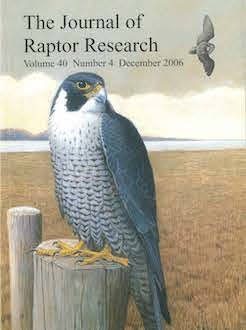Monogamy is the most common mating system in diurnal birds of prey, although cooperative breeding has been described in at least 14% of these species (Kimball et al. 2003, Auk 120:717–729). In most instances this was occasional, with the most common form of cooperative breeding being one adult female and two adult males (Kimball et al. 2003).
The Eurasian Buzzard (Buteo buteo) is generally considered a monogamous species (Cramp and Simmons 1980, The birds of the western palearctic, Vol. 2, Oxford University Press, Oxford, U.K.; del Hoyo et al. 1992, Handbook of the birds of the world, Vol. 2, Lynx Edicions, Barcelona, Spain) although some slight interactions among adjoining breeding birds have been described (e.g., common aerial meeting points, Cerasoli and Penteriani 1996, J. Raptor Res. 30:130–135). We here present the first evidence of cooperative breeding for this species (see review in Kimball et al. 2003). We monitored 31 breeding territories of the unmarked population on Fuerteventura Island (Canary Islands, 28°35′N, 13°58′W) during the 2005 breeding season and we recorded one polyandrous association of one female and two males (determined by size and copulative behavior).
We observed the three hawks in the breeding territory during the six visits we made to the nest from 21 March to 30 April 2005. The three individuals took part in reproductive displays such as courtship flights, landing on the nest and active defense of their territory against Common Ravens (Corvus corax). On 1 April the female was incubating and left the nest to copulate with one of the males perched on top of the cliff where the nest was situated. Immediately the other male, perched only 10 m away on the same cliff, flew to the nest and began incubating. The trio incubated four eggs, a relatively large clutch (population mean = 3.00 ± 0.67 (SD), N = 31), until 1 April, at which time only two eggs remained in the nest; we found the remains of the other two in the surrounding area. The incubation of the two remaining eggs continued until approximately 12 April, when the trio finally abandoned the nest with only one egg remaining. We observed the birds in the vicinity of the nest for several more days and the territory was definitively abandoned on 30 April. Although without genetic analyses it was not possible to check paternities, the absence of aggression between males and the habitual presence of three birds in the nest vicinity and at the nest led us to assume that the three hawks formed the breeding unit.
Many hypotheses can explain polyandry phenomena (see review in Kimball et al. 2003), and although further studies are necessary to determine the actual cause, three of these might explain the case presented here. The first is the patchiness of food resources (Kimball et al. 2003). We examined distribution maps of the buzzards' two main prey species [European rabbit (Oryctolagus cuniculus) and Barbary ground squirrel (Atlantoxerus getulus); Gangoso and López-Darias 2004, Estado de la población de Aguililla (Buteo buteo insularum) en Fuerteventura (Islas Canarias), Estación Biológica de Doñana and Cabildo Insular de Fuerteventura, unpubl. report], and found that the higher densities of Buzzards were associated with areas of greater prey abundance (López-Darias unpubl. data); the polyandrous trio association was located in one of the areas with higher densities of buzzard territories. The cooperative breeding trio may provide its members advantages in competing with other nearby pairs. Second, the limited number of suitable breeding territories (e.g., Faaborg 1986, Ibis 128:337–347; Heredia and Donázar 1990, Biol. Conserv. 53:163–171; Tella 1993, J. Raptor Res. 27:119–120), might be another possible explanation. In the last three decades, the buzzard population on Fuerteventura Island has undergone a significant increase from 5–7 breeding pairs to over 100 breeding pairs (Gangoso and López-Darias 2004), and Eurasian Buzzards on Fuerteventura nest primarily on small, interior cliffs, which have limited distribution on the island. Third, the high rate of nest predation by Common Ravens in the area (López-Darias unpubl. data), also documented in other islands (Martín and Lorenzo 2001, in F. Lemus [Ed.], Aves del Archipiélago Canario, La Laguna, Spain), might result in increased territory defense facilitated by the formation of polyandrous trios.
Thus, the limited nest site availability, the patchy distribution of prey, or the high density of potential nest predators might have led to the establishment of a breeding trio in this resource-rich territory. If so, the subordinate male might be compensated for his cooperation as a secondary male by the possibility of acquiring a resource-rich territory after the death of the dominant male (Faaborg 1986, Heredia and Donázar 1990, Tella 1993).
Although the polyandrous breeding association could have many potential benefits, we note that the reproductive effort of this trio was not successful in this case. Despite the fact that the clutch size was larger than the population mean, the expected higher vigilance and defense capacity did not result in higher productivity.
This research was partially financed by La Caja de Canarias and Cabildo Insular de Fuerteventura. We are also grateful to Cabildo Insular de Fuerteventura for the accommodation provided during the fieldwork, to L. Gangoso for providing useful references, to F. Hiraldo for valuable suggestions on the first draft, and to A. Hansen for checking the English translation. J.D. Ludwig and an anonymous referee provided useful comments to the final version. This work forms part of the doctoral thesis of M. López-Darias, which was funded by the Ministerio de Educacion y Ciencia through an FPU Fellowship (AP20023045). Rafael Barrientos was funded by the Ministerio de Ciencia y Tecnología through an FPI Fellowship (BES-2003-0189) within the framework of the project REN2002-00169.





